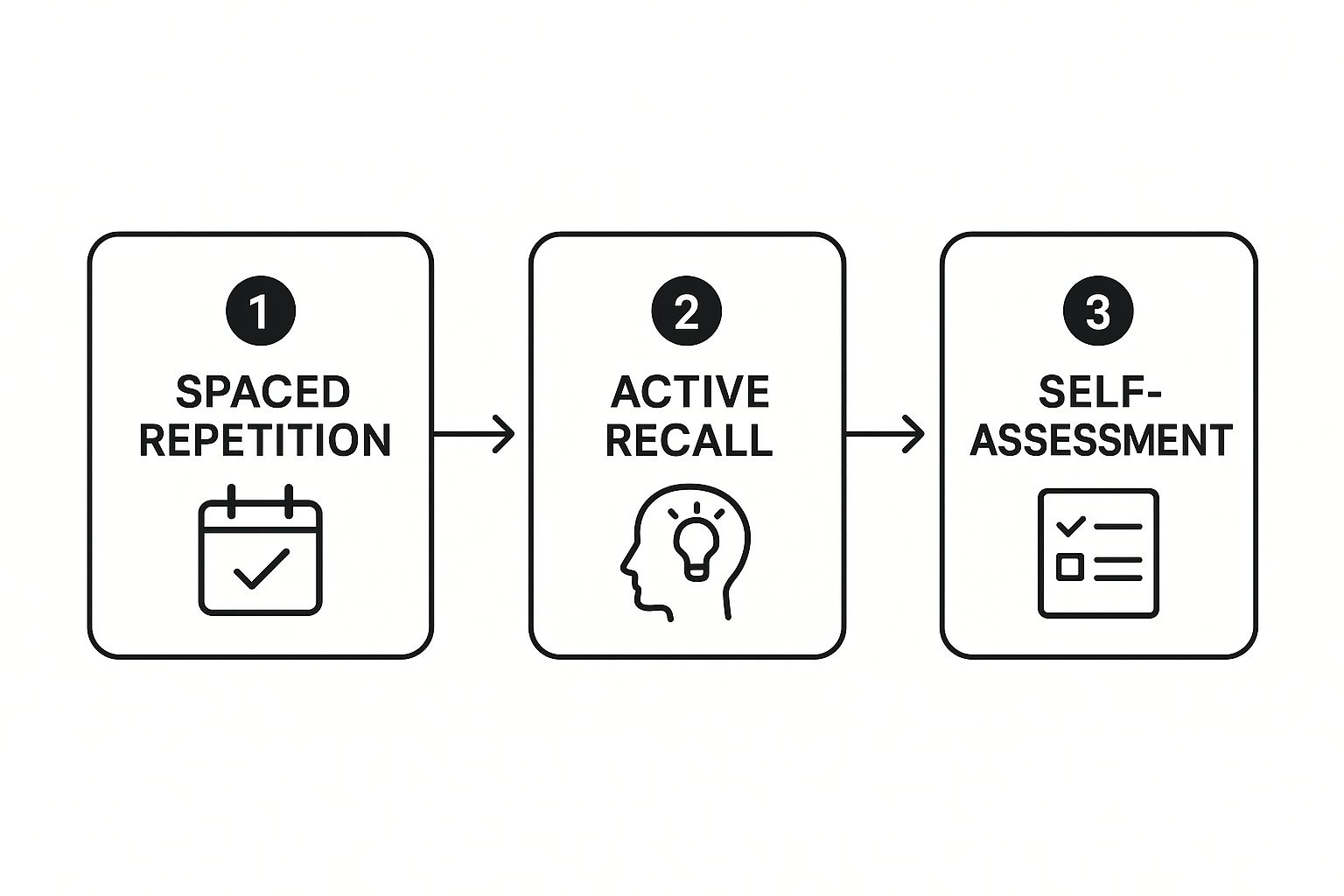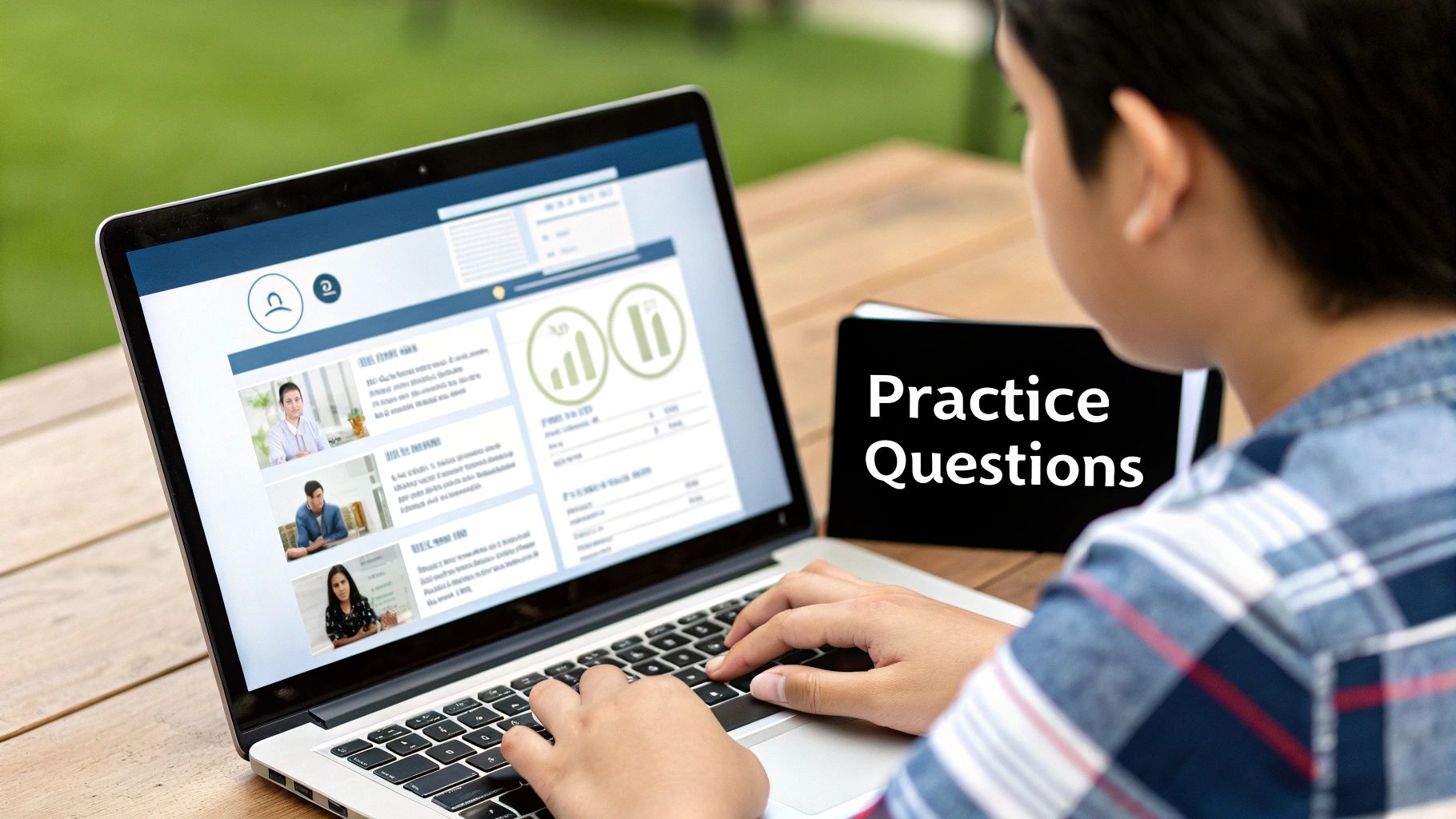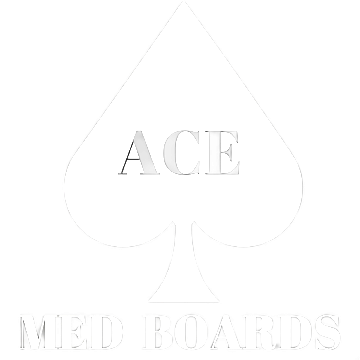A solid USMLE Step 1 study plan is your personal roadmap for surviving the months of dedicated prep. It’s what turns a mountain of information into manageable, day-to-day tasks. A good plan isn't just a calendar—it's a system for choosing high-yield resources, scheduling content review and practice questions, and building in checkpoints to make sure you're on track to pass.
Your Blueprint for Acing the USMLE Step 1

Let's be clear: creating a study plan that actually works is about more than just downloading a template and filling in the blanks. You need to design a system that fits you—your learning style, your timeline, and your specific knowledge gaps. Whether you've got six months or a crunched six-week dedicated period, the core principles don't change. Your goal is to build a living, breathing blueprint that guides you from day one all the way to test day.
The biggest mental shift you need to make is recognizing how the exam has changed. With the move to pass/fail, the game is no longer about chasing a sky-high score. It's about building a deep, foundational understanding of the material. Rote memorization is out; integrated clinical reasoning is in. This means your plan has to prioritize active learning—think grinding through UWorld questions—over passive stuff like re-watching lectures.
Ultimately, your entire study period is a high-stakes project in self-management. It’s incredibly helpful to understand how to build effective personal productivity systems so you can make every hour count.
The New Reality of Pass/Fail
You might think the switch to pass/fail lowered the stakes, but the data tells a different story. If anything, it's made having a structured plan more critical than ever. Back in 2021, before the change, the first-time pass rate for U.S. MD students was a solid 95%. That number dipped to 91% in 2022 and then settled at 90% in 2023.
This trend points to one thing: without the pressure of a three-digit score hanging over their heads, some students are underestimating the exam's difficulty. A well-thought-out plan is your best defense against that kind of complacency.
A robust study plan is built on a few essential pillars. These components work together to create a strong foundation for your prep. Neglecting any one of them can create serious weak spots.
Here's a quick look at the core components every successful Step 1 study plan needs to include.
Table: Core Components of a Successful Step 1 Study Plan
| Component | Key Objective | Example Action |
|---|---|---|
| Baseline Assessment | To identify your weak areas from the very beginning. | Take a full-length NBME practice exam before starting your dedicated study period. |
| Resource Integration | To create a seamless workflow between your primary study tools. | Annotate your First Aid book with key takeaways from UWorld explanations. |
| Structured Flexibility | To build a resilient schedule that prevents burnout. | Set daily goals (e.g., complete 80 UWorld questions) instead of a rigid, hour-by-hour schedule. |
| Consistent Evaluation | To track your progress and adjust your strategy in real-time. | Schedule an NBME or UWSA every 1-2 weeks to simulate exam conditions and monitor your score trend. |
Thinking about these four pillars—assessment, integration, flexibility, and evaluation—will help you build a plan that's not just a schedule, but a true strategy for success.
Building Your High-Yield Resource Arsenal

Choosing your Step 1 resources can feel like being told to pack for a year-long trip with only a carry-on. The sheer number of options is paralyzing. But here’s the truth: success isn’t about using everything. It’s about picking a few powerful tools and mastering them.
The single biggest mistake I see students make is resource overload. Trying to juggle a dozen different platforms is a surefire way to burn out while only gaining surface-level knowledge. Let's cut through the noise and focus on what actually works.
The Essential Trinity
For the vast majority of students, a killer Step 1 prep plan is built on three core pillars. Don't think of these as separate items on a checklist; they're an integrated system designed to work together.
- UWorld (The Grinder): This is where the real work happens. The Qbank isn’t just about testing what you know—it's your primary learning tool. The explanations are gold, teaching you the why behind every concept. You'll spend most of your active study hours right here.
- First Aid (The Bible): This book is the condensed blueprint for the entire exam. It's dense, and it's not meant to be read like a novel. Its real power is unlocked when you use it as a scaffold to hang all the knowledge you gain from other resources.
- Pathoma (The Foundation): Dr. Sattar's videos are legendary for a reason. Pathology is a massive chunk of Step 1, and Pathoma gives you the conceptual framework you need to understand it cold. Mastering this gives you the bedrock to correctly work through complex clinical vignettes.
The magic happens when you make these three resources talk to each other. For example, finish a block of UWorld cardiology questions, then immediately open First Aid to the cardio section. Start annotating it with insights, mnemonics, and diagrams from the UWorld explanations. This simple habit transforms First Aid from a generic textbook into your personalized, high-yield masterpiece.
Powerful Supplements for Active Recall
Once you have your core trinity locked in, you can strategically add a couple of supplements to supercharge your retention. These tools are built for active recall and spaced repetition—scientifically proven methods for lodging information in your long-term memory.
The two I recommend above all others are:
- Sketchy Medical: An absolute lifesaver for visual learners, especially for microbiology and pharmacology. The bizarre and memorable visual mnemonics are what you'll recall when you're under pressure trying to remember an obscure drug side effect.
- Anki: This smart flashcard app is a game-changer. It uses a spaced repetition algorithm to show you facts right as you're about to forget them. The highest-yield approach isn't downloading a massive pre-made deck; it's creating your own cards based on concepts you get wrong in UWorld.
Pro Tip: Don't just copy facts into Anki. Force your brain to work. Instead of a card that says, "Hartnup disease is caused by a deficiency of neutral amino acid transporters," frame it as a question: "What is the underlying defect in Hartnup disease?" This forces active retrieval, which is what builds strong memories.
Tailoring Resources for Your Situation
Of course, your personal background matters. An International Medical Graduate (IMG), for example, might have a different knowledge base than a U.S. med student and will need to adjust.
Let’s say an IMG is consistently getting pharmacology questions wrong. Their foundational knowledge in that area might just be a bit weaker. A smart tweak to their usmle step 1 study plan would be to watch all the Sketchy Pharm videos for a given system before even touching the UWorld questions for it. This front-loads the visual framework, making the Qbank practice far more effective. For more on this, check out this guidance on choosing the right study material for USMLE Step 1.
Ultimately, your goal is to build a lean, mean, streamlined arsenal. Resist the urge to add every shiny new resource your classmates are buzzing about. Stick to your core, integrate them intelligently, and use supplements only to fill specific, identified gaps. A focused approach will always beat a scattered one.
Designing a Study Timeline That Fits You
Trying to force a generic, one-size-fits-all study schedule is one of the fastest routes to burnout. Your USMLE Step 1 plan has to be built around you—your current knowledge, your med school's curriculum, and whether you're working with a six-week dedicated block or a six-month integrated learning window.
The goal isn't to follow a rigid script. It's to build a dynamic framework that you can adjust as you go.
The very first, non-negotiable step? Establish your baseline. Before you even touch a calendar, you need to take a full-length NBME practice exam. This isn't about chasing a high score; it's purely about data collection. The results will give you an honest, unbiased look at your strengths and weaknesses, pointing you directly to the organ systems or disciplines that need the most work.
From Baseline Assessment to Calendar Blocks
Once you have your NBME results in hand, it's time to get tactical. Print out a calendar for your entire study period and start blocking out your time. But don't just scribble "Study" across every day. Get specific. Allocate more time—entire days or even weeks—to the subjects where you performed poorly on your baseline.
If biochemistry was your weakest area, it gets more real estate on the calendar. Simple as that.
This initial structure is your starting point. For a typical dedicated study period, the approach usually breaks down into two main phases:
- Content Review Phase (First 50-60% of your time): This is where you systematically grind through high-yield resources like Pathoma and Sketchy. Pair this with subject-specific UWorld blocks in tutor mode to build and reinforce your foundational knowledge.
- Integration Phase (Final 40-50% of your time): Now, you shift gears. The focus moves to random, timed 40-question UWorld blocks to simulate real exam conditions. This phase is less about pure content absorption and more about building timing, endurance, and the mental agility to jump between different medical concepts.
A huge pitfall I see all the time is students getting stuck in passive content review. Your plan should be heavily skewed toward active learning. A good rule of thumb is to spend at least 60-70% of your daily study time actively doing and reviewing practice questions.
The gravity of this exam has always been significant. The USMLE Step 1 has long been a critical milestone, and schools often tie academic progression to a passing score. Failing, even once, can lead to serious setbacks. Research has shown that roughly 10% of students who initially failed Step 1 either withdrew or were dismissed from their programs. This context really drives home why a multi-month, meticulously planned study approach is so critical.
The infographic below shows the core learning cycle that should drive your daily grind. It's a powerful loop that blends different cognitive techniques to make information actually stick.

This flow shows how spaced repetition feeds into active recall, which you then validate through self-assessment. It’s a simple but incredibly effective system.
Crafting Your Weekly Template
With the big picture mapped out, you can zoom in and design a sample weekly schedule. Think of this as a guide, not a prison. The key is to find a sustainable balance between intense study and the downtime your brain needs to consolidate everything.
Here’s a practical example of what a week might look like during your dedicated period:
| Day | Morning Session (8 AM – 12 PM) | Afternoon Session (1 PM – 5 PM) | Evening (7 PM – 9 PM) |
|---|---|---|---|
| Mon-Fri | 2x UWorld Blocks (40 Qs, Timed) | Deep review of morning blocks | Targeted content review (e.g., Pathoma, Sketchy) or Anki |
| Saturday | Full-length NBME/UWSA Exam | Review incorrects from practice exam | Light review or relax |
| Sunday | REST DAY | No studying. Recharge for the week ahead. | No studying. |
This kind of structure ensures you're consistently practicing under exam conditions, but it also carves out plenty of time for review—which, frankly, is where most of the real learning happens. And don't skip that day off. Protecting your well-being is part of the strategy.
For more detailed examples, our guide on creating a USMLE Step 1 preparation timetable offers some additional structured templates you can adapt.
Remember, the best usmle step 1 study plan is one that evolves with you. If you notice you're consistently bombing renal physiology questions, adjust next week's schedule to hit that topic harder. Your plan is a living document, a tool you should feel empowered to change based on the continuous feedback you get from practice questions.
Mastering Your Daily and Weekly Study Workflow

This is where the high-level planning meets the pavement. A great USMLE Step 1 study plan is built one day at a time, but a "productive day" is about way more than just logging hours. It's about structuring your workflow to maximize focus and retention, getting you out of the passive video-watching zone and into active, engaged learning.
Forget those draining eight-hour marathon study blocks that just leave you fried. A much better approach is to break your day into focused sprints. The Pomodoro method is a classic for a reason: work in intense 25-minute bursts followed by a 5-minute break. This isn't just about managing time; it's about managing your mental energy so you stay sharp from your first question to your last Anki card.
Structuring the Perfect Study Day
A truly effective day has a distinct rhythm. You start with assessment, move into deep review, and finish with targeted reinforcement. Following this structure means you're constantly finding and patching up your knowledge gaps in real-time.
Here’s a practical, battle-tested daily schedule that just works:
- Morning (8 AM – 12 PM) – Assessment: Kick off your day with two timed, random 40-question UWorld blocks. This is non-negotiable. Hitting questions when your mind is freshest simulates exam conditions and gives you the raw material for the rest of your day's learning.
- Afternoon (1 PM – 5 PM) – Deep Review: This is where the magic happens. Dedicate these four hours to a meticulous review of the 80 questions you just did. Your goal isn't just to see what you got wrong—it's to understand why the right answer was right, why every single wrong answer was wrong, and the core concept the question was testing.
- Evening (7 PM – 9 PM) – Targeted Reinforcement: Let your UWorld performance be your guide. If you bombed a bunch of questions on adrenal physiology, this is your time to pull up that Pathoma chapter, watch the corresponding Sketchy video, and then unsuspend those specific cards in your Anki deck.
This workflow creates a powerful feedback loop. The questions you miss in the morning directly tell you what to study in the evening, making sure every session is perfectly aimed at your weaknesses. This laser-focused approach is a cornerstone of an efficient usmle step 1 study plan.
A classic mistake is spending an hour on a UWorld block and only an hour reviewing it. You need to flip that ratio. A thorough review—one that involves making flashcards and cross-referencing First Aid—should take at least 1.5 to 2 times as long as it took to answer the questions. That’s where the real learning happens.
Weaving Your Resources Together
Integrating your study materials is an art. Don't treat each resource like a separate item on a checklist. Instead, make them work together in a seamless flow. This reinforces concepts from multiple angles, which is what really cements them in your memory.
Let's say you get a UWorld question wrong about different types of diuretics. An integrated workflow would look something like this:
- Review: First, read the UWorld explanation until you truly get it.
- Consolidate: Then, open First Aid to the renal pharmacology section and annotate it with the key insight you just learned from UWorld.
- Visualize: Next, pull up the Sketchy Pharm video on diuretics for a powerful visual mnemonic that will stick.
- Reinforce: Finally, make a few targeted Anki cards based on the specific concept you missed.
This multi-modal approach hits the concept from different angles. To really lock in that information for the long haul, you'll want to master spaced repetition studying. The combination of doing questions and reviewing them at spaced-out intervals is what makes information stick for good.
The Weekly Check-In and Consolidation Day
Your weekly routine needs to build toward a day dedicated to consolidation and assessment. For most students, Saturday is the perfect day for this. Use this day to take a full-length practice exam, like an NBME or a UWSA, under strict, timed conditions.
This weekly simulation does two critical things. First, it builds the mental and physical stamina you'll need for the grueling 8-hour test day. Second, it gives you the hard data you need to track your progress and tweak your plan for the week ahead. The review of that practice exam becomes your road map, highlighting exactly which topics need more of your attention.
Here is a sample framework of what a dedicated study week could look like, balancing new questions with deep review and vital rest.
Sample Weekly Study Schedule Framework
| Day | Morning Session (4 hours) | Afternoon Session (4 hours) | Evening Session (2 hours) |
|---|---|---|---|
| Monday | 2 UWorld blocks (80 questions) | Deep review of morning blocks | Targeted content review (Pathoma, Sketchy, etc.) |
| Tuesday | 2 UWorld blocks (80 questions) | Deep review of morning blocks | Targeted content review & Anki |
| Wednesday | 2 UWorld blocks (80 questions) | Deep review of morning blocks | Anki & review of weak topics from previous days |
| Thursday | 2 UWorld blocks (80 questions) | Deep review of morning blocks | Targeted content review (Pathoma, Sketchy, etc.) |
| Friday | 2 UWorld blocks (80 questions) | Deep review of morning blocks | Anki & final review for weekly assessment |
| Saturday | Full-length Practice Exam (NBME/UWSA) | Review incorrects from practice exam | Light review or rest |
| Sunday | Rest, errands, light Anki review | Plan for the upcoming week | Complete rest / recharge |
By combining a structured daily workflow with a disciplined weekly review, you move beyond just "studying" and start training like an elite academic athlete. You're building systems that support deep learning through powerful techniques like active recall, which is absolutely fundamental for exam success. If you want to go deeper on this, exploring the principles of active recall for medical students can give you a significant edge.
Navigating Plateaus and Common Study Pitfalls
Every single medical student hits a wall during their dedicated study period. It's almost a rite of passage. One week your practice scores are climbing steadily, and the next, you’re completely stuck. This is the dreaded USMLE plateau, and while it’s incredibly frustrating, it’s also a completely normal part of the process.
Pushing through isn't about brute force—it's not about studying harder. It’s about getting smarter and diagnosing the root cause of why you’ve stalled out.
When your scores flatline, you need to stop being a student for a moment and become a data analyst. Mindlessly grinding through more questions without a strategy is like throwing darts in the dark and hoping you hit the bullseye. Instead, you need to dive deep into your UWorld or NBME performance reports. Are you consistently missing questions from a specific organ system, like renal or reproductive? Or is the problem more subtle—maybe you're struggling with questions that require multi-step reasoning or interpreting tricky lab values.
Pinpointing the exact nature of your weakness is the only way to break through. A successful USMLE Step 1 study plan has to be flexible enough to adapt to these challenges.
Breaking Through Your Score Plateau
Once you’ve identified the problem area, your next move is a targeted intervention. This means temporarily shifting your daily workflow to attack that specific weakness with everything you've got. For example, if you realize that pharmacology questions are your kryptonite, dedicate your evening reinforcement sessions exclusively to pharm for an entire week.
This kind of focused attack could look like:
- Binge-watching all the Sketchy Pharm videos for a system you're weak in.
- Creating a specific Anki deck just for drug mechanisms and side effects.
- Doing 20-question UWorld blocks composed only of pharmacology questions to really see the patterns in how they're tested.
This laser-focused approach is far more effective than just continuing with random question blocks and hoping for the best. You're actively patching the holes in your knowledge base instead of just skimming over them again and again.
Unique Challenges for International Medical Graduates
For International Medical Graduates (IMGs), the journey to residency often comes with its own set of hurdles. Beyond navigating the complexities of the match, many IMGs are working from a different foundational science curriculum, which can create unexpected and frustrating knowledge gaps. The pressure is immense, and the statistics really underscore the need for a rigorous, well-structured plan.
In 2023, while 98% of U.S. and Canadian MD graduates passed Step 1 on their first attempt, the first-time pass rate for non-U.S./non-Canadian graduates was 72%. Even more telling, the pass rate for IMGs taking the exam a second time dropped to just 47%. These numbers aren't meant to scare you; they're meant to show why a longer, more structured study period is often necessary to master both the content and the exam's unique question style. You can find more details in these USMLE pass rate statistics on worldpopulationreview.com.
Managing Test Anxiety and Burnout
Let's be clear: your mental and physical well-being are not luxuries during Step 1 prep. They are essential, non-negotiable components of your study plan. Ignoring them is a surefire recipe for burnout, which can derail even the most meticulously crafted schedule. Test anxiety is real, and it can absolutely cripple your performance on exam day if you don't get a handle on it.
The goal isn't to eliminate stress entirely—that's impossible. The goal is to manage it so it doesn't get in the way of your ability to recall information and think through complex clinical vignettes under pressure.
Here are a few practical strategies to keep burnout at bay and manage that ever-present anxiety:
Protect Your Time Off: Seriously. Schedule at least one full day off per week where you do absolutely no studying. This is non-negotiable if you want to make it to the finish line without crashing.
Practice Mindfulness and Simulation: Regularly taking full-length practice exams does more than just assess your knowledge—it desensitizes you to the pressure. Pair this with simple mindfulness exercises or deep-breathing techniques for just a few minutes each day, and you can significantly lower your baseline anxiety.
Maintain Your Physical Health: Your brain runs on what you give your body. Prioritize 7-8 hours of sleep, try to get at least 30 minutes of physical activity in daily, and fuel yourself with nutritious food. Your cognitive performance is directly tied to your physical state.
Ultimately, learning to navigate the inevitable pitfalls of Step 1 prep is a skill in itself. By learning to analyze your performance, manage your well-being, and adapt your strategy on the fly, you build the resilience you need to cross that finish line successfully.
Answering Your Top Step 1 Planning Questions
Even with a perfect framework, you're going to have questions once you're in the trenches of building your Step 1 schedule. These are the practical, "what-if" scenarios that can throw you off course and cause a ton of unnecessary stress. Let's get these sorted out right now so you can move forward with confidence.
Getting these details right isn't just about checking a box; it’s about building a plan that's resilient enough to handle the pressures of dedicated study.
How Long Should My Dedicated Study Period Be?
This is the million-dollar question, and the only honest answer is: it depends. There’s no magic number, but we have some pretty reliable guidelines based on thousands of students' experiences.
For most U.S. medical students, a 6 to 10-week dedicated period is the sweet spot. That’s generally just enough time to get through a full pass of UWorld and review your high-yield resources without hitting a wall of complete burnout.
The calculation is totally different for International Medical Graduates (IMGs), though. A longer timeline, usually between 4 to 6 months, is far more realistic and frankly, highly recommended. This gives you the runway to build a rock-solid foundation in the basic sciences and truly master the unique question style of the USMLE.
The single biggest factor for everyone is your baseline score. You absolutely must take an NBME practice exam before you start. If that score is way below passing, you have to plan for a longer study period. Your timeline needs to be long enough to cover your core resources well, but not so long that you start forgetting what you learned in the first few weeks.
What Is the Best Way to Use UWorld?
Let's get one thing straight: UWorld is not just a practice test. It is your single most important learning tool. Treating it as a simple assessment is one of the biggest mistakes you can make.
The most effective way to tackle it is in two distinct phases.
Phase 1: The Learning Phase. Early in your schedule, do UWorld blocks in tutor mode, sorted by subject. This lets you build a deep foundation in one system at a time. The goal here isn't speed; it's understanding. Read every single word of every explanation, even for questions you got right. This is where you’ll be making your best Anki cards or annotating First Aid.
Phase 2: The Simulation Phase. As you get closer to your exam, switch gears. Start doing timed, random blocks of 40 questions. This pivot is critical. It builds your mental stamina and trains your brain to switch between subjects on the fly, exactly like you'll have to on the real deal.
A non-negotiable rule of thumb: spend at least as much time reviewing a block as you did taking it. Just looking at your score is useless. The real learning happens when you dig into why you got a question wrong.
How Many Practice Exams Should I Take and When?
Practice exams are your checkpoints. They're how you track progress, manage test-day anxiety, and get the most accurate prediction of where you stand. You should plan to take at least 4-5 full-length practice exams.
Here’s a schedule that works for most students:
- Baseline NBME: Take this before dedicated even starts. This is purely diagnostic. It’s meant to show you where you're weakest so you can build your schedule around those topics.
- Mid-Prep UWSA 1: Schedule the first UWorld Self-Assessment around the halfway point. It’s a great reality check to see if your study strategies are actually paying off.
- Progress NBMEs: After that halfway mark, sprinkle in another NBME every 1-2 weeks. This keeps you honest about your progress and gets you comfortable with the real exam interface.
- Final Week UWSA 2: Take the second UWorld Self-Assessment about one week out from your test date. This score is notoriously predictive and can be a massive confidence booster going into the final stretch.
- Last Days Free 120: A few days before your exam, work through the official Free 120 questions from the USMLE website. These are the closest you'll get to the style and feel of the questions on test day.
How Do I Avoid Burnout During My Study Period?
Preventing burnout isn't a sign of weakness; it's a strategic advantage. A fried brain doesn't learn, and it definitely doesn't recall information under pressure. Protecting your mental health is a high-yield activity.
First, your schedule has to be realistic and include protected time off. This is non-negotiable. Carve out at least one full day or two half-days per week where studying is completely forbidden.
Next, make your well-being a priority. This means actually getting 7-8 hours of sleep a night, moving your body every day, and eating meals that fuel your brain instead of putting you in a food coma.
Finally, structure your study days for focus, not just endurance. Use a technique like the Pomodoro method (study for 25 minutes, break for 5) to stay sharp. If you feel yourself hitting a wall, it’s far more productive to take an unscheduled afternoon off to reset than to stare blankly at a page, retaining nothing. This is a marathon, not a sprint.
Crafting the perfect USMLE Step 1 study plan is a deeply personal journey, but you don't have to figure it all out alone. If you're looking for an expert to help analyze your performance, target your weak spots, and build a schedule that truly works for you, the tutors at Ace Med Boards are here to help.
Start with a free consultation today at Ace Med Boards to build your path to success.
